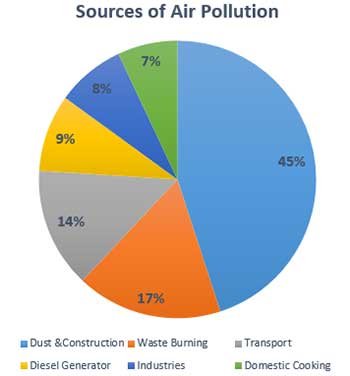Daily-current-affairs
/
21 Oct 2020
Air Pollution Now Biggest Health Risk in India : Daily Current Affairs

Air Pollution Now Biggest Health Risk in India
Why in NEWS ?
- Long-term exposure to outdoor and
household air pollution contributed to over
1.67 million annual deaths from stroke, heart
attack, diabetes, lung cancer, chronic lung
diseases and neonatal diseases in India in
2019.
ABOUT
- According to the State of Global Air 2020 by
the U.S.-based Health Effects Institute overall,
air pollution was now the largest risk factor
for death among all health risks.
- Outdoor and household particulate matter pollution also contributed to the deaths of more
than 1,16,000 Indian infants in their first month of life last year.
- More than half of these deaths were associated with outdoor PM2.5 and others were linked to
use of solid fuels such as charcoal, wood, and animal dung for cooking.
- India faced the highest per capita pollution exposure — or 83.2 μg/cubic metre — in the world,
followed by Nepal at 83.1 μg/cubic metre and Niger at 80.1.
AIR POLLUTION
- The Air (Prevention and Control of Pollution) Act was passed in 1981 to regulate air pollution but
has failed to reduce pollution because of poor enforcement of the rules.
- NATIONAL AIR QUALITY INDEX (NAQI) was launched in 2014 with outline tag ‘One Number –
One Color -One Description’ for the people to judge the air quality within their residing vicinity..
- It has been launched for monitoring the air quality in major urban centers across the country on
a real-time basis and enhancing public awareness for taking precautionary measure.
- The measurement of air quality is based on eight pollutants, namely,
- Particulate Matter (PM10), Particulate Matter (PM2.5), Nitrogen Dioxide (NO2), Sulphur Dioxide
(SO2), Carbon Monoxide (CO), Ozone (O3), Ammonia (NH3), and Lead (Pb).
- AQI has six categories of air quality. These are: Good, Satisfactory, Moderately Polluted, Poor,
Very Poor and Severe.(please refer the chart below)
| AQI |
Remark |
Color Code |
Possible Health
Impacts |
| 0-50 |
Good |
|
Minimal impact |
| 51-100 |
Satisfactory |
|
Minor breathing discomfort to sensitive
people |
| 101-200
|
Moderate |
|
Breathing discomfort to
the people with lungs,
asthma and heart diseases |
| 201-300 |
Poor |
|
Breathing discomfort to
most people on
prolonged exposure |
| 301-400 |
Very Poor |
|
Respiratory illness on
prolonged exposure |
| 401-500 |
Severe |
|
Affects healthy people
and seriously impacts
those with existing
diseases |
CONCLUSION
- This newest evidence suggests an especially high risk for infants born in South Asia and sub-
Saharan Africa.
- Although there has been slow and steady reduction in household reliance on poor-quality fuels,
the air pollution from these fuels continues to be a key factor in the deaths of these youngest
infants.
- The government has claimed that average pollution levels in India are declining over the past
three years but these have been marginal.







